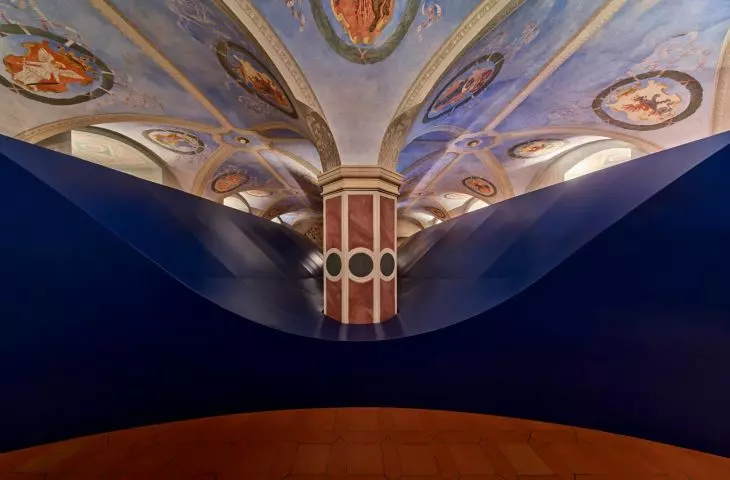Nine masterpieces of the Italian Renaissance, including some from the collection of the Accademia Carrara in Bergamo, are on display in the Former Chamber of Deputies at the Royal Castle in Warsaw. The unique paintings are framed in an intriguing frame overflowing with inspirations drawn from the Renaissance and historical interiors - a monumental display designed by Bartosz Haduch and Łukasz Marjański of the NArchitekTURA studio.
At the temporary exhibition (the exposition can be admired until September 18 this year) "Botticelli tells the story. Paintings by Renaissance masters from the collection of the Accademia Carrara," curated by Mikolaj Baliszewski and Cristina Rodeschini, features paintings by such artists as Giovanni Bellini, Cosmè Tura, Vittore Carpaccio, Lorenzo Lotto, Giovan Battista Moroni, Paolo Veronese, Defendente Ferrari and Jacopo Bassano. However, the first fiddle is played in this space by the work "History of Virginia" by the Florentine master and title character of the exhibition - Sandro Botticelli.
© Royal Castle in Warsaw
dialogue between art and architecture
(Exhibition Arrangement) is more an attempt to stage a multifaceted dialogue: between art and architecture, modernity and history, the creators of the exhibition and its audience.... - explained Bartosz Haduch in an interview (you can find the entire conversation in the November issue of A&B).
This multifaceted dialogue is also evident in the latest exhibition arranged by architects from the NArchitekTURA studio - through an eye-catching visual form, its creators refer to both the space of the castle hall, Renaissance art and individual exhibits.
In the former Chamber of Deputies at the Royal Castle in Warsaw, you can admire masterpieces of the Italian Renaissance
photo: Jakub Certowicz
day and night
The richly decorated Former Chamber of Deputies, reconstructed after the war to a design by Giovanni Battista Quadro, is dominated by cross vaults supported on three columns decorated with coats of arms placed against a background resembling a cloud-filled blue sky. It was this painterly decoration that inspired the architects.
The new monumental form placed in the central part of the hall was to be a reflection (literal and indirect) of the existing ceiling, explains Bartosz Haduch. - The concave arch in the middle of this display is the negative of the vaulted ceiling above, creating in cross views a kind of illusory "sine wave" linking the two - contemporary and historical. The dark blue color (originally inspired by the color of the apse finial seen in the Botticelli painting on display and a shade of the famous lapis lazuli pigment) is in fact a repeatedly darkened hue of the existing vault. While the historic ceiling is meant to illustrate a daytime view of the sky, the newly designed object is meant to suggest the same view, but at night, the author adds.
The paintings are presented on the longer sides of the dark blue block
Photo: Jakub Certowicz
old and new
Monumental, sculpted masses building up the exhibition space are already a hallmark of Krakow's designers - we could see a similar procedure at the monographic exhibition of Stanisław Wyspiański at the National Museum in Krakow or in the spaces of the Manggha Museum of Japanese Art and Technology at last year's exhibition devoted to the work of Japanese painter and wood engraver Katsushiki Hokusai. In each of these cases, the monochromatic solids were and are not only a strong architectural accent in the space, but also the main element of the aforementioned dialogue.
The reflective, twisted planes reflect, darken and distort the image of the existing room, which may bring to mind the Renaissance optical corrections used in both art and architecture. The symmetrical, harmonious geometry of the new structure is also a nod to the ideals of the Age of Enlightenment. The reflection effect used is intended to "dematerialize" and "defragment" the architecture of the Former Chamber of Deputies, complementing it and giving it a new quality and blurring the boundaries between what is old and what is new, the author explains the solution.
The concave arch in the middle of the display is the negative of the vaulted ceiling
Photo: Jakub Certowicz
The dark blue solid resembles a cuboid, whose walls and edges are more-or-less gently curved inward. The effect? Visitors to the exhibition may get the impression that existing columns have been sunk into the display, and the inviting concavity of the walls allows them to get closer to the paintings presented on the longer, opposite sides. Eight of them are juxtaposed into a single composition, and the aforementioned main protagonist - a painting by the author of, among other things, the famous "Birth of Venus" - has been given its own space and an extensive description of individual scenes of the dramatic story of Virginia, daughter of the plebeian centurion Lucius Verginius.
The main character of the exhibition is the work "History of Virginia" by Sandro Botticelli
photo: Jakub Certowicz
In addition to thoughtful elements of small architecture, visual identification or discreet lighting, the exhibition is complemented by quiet instrumental music created by the duo Hania Rani and Dobrawa Czocher.
All this creates a holistic vision of the exhibition, based on specific multithreaded inspirations, but open to different ways of perception and interpretation. This temporary arrangement of the exhibition in one of the most important halls of the Royal Castle in Warsaw is a space on the borderline between history and the present, reality and illusion, architecture and art," concludes Bartosz Haduch.
Most of the paintings come from the collection of Accademia Carrara in Bergamo
photo: Jakub Certowicz
This is not the only exhibition designed by the NArchitekTURA studio to be admired at the royal castle. We are, of course, talking about the ongoing exhibition "Masterpieces from the Lanckoroński collection" at Wawel , which we will write about soon!









































